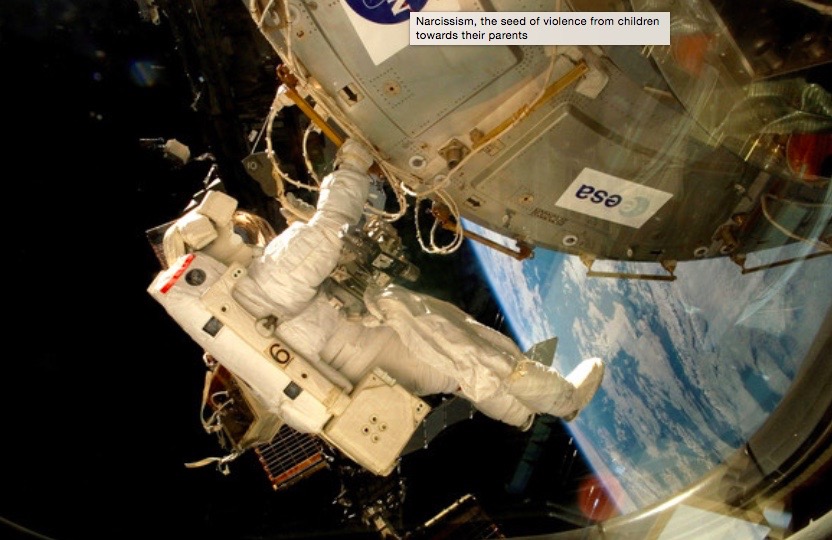Astronauts' Back Pain Has Surprising Cause

Astronauts may have no trouble moving heavy objects in the weightlessness of space, but that doesn't mean that the experience isn't hard on their backs. Astronauts on long-duration spaceflights routinely report back pain, both during and after the flight. Now doctors think they know what's causing this.
In a new study, researchers used magnetic resonance imaging (MRI) scans to observe the spines of six NASA astronauts before they landed, at the time of landing and about two months after they had spent upward of seven months on the International Space Station. The researchers found that the prolonged exposure to weightlessness weakened the muscles supporting the astronauts' spines.
The discovery runs counter to the theory that the astronauts' back pain is caused by the swelling of their spinal disks, the shock-absorbing cushions between the vertebrae, the researchers said. The findings, which were published today (Oct. 25) in the journal Spine, suggest that special back-strengthening exercises, including yoga, could help astronauts minimize or avoid back pain, the researchers said. [The Best Back Exercises for Preventing Injury and Reducing Pain]
Astronauts face numerous health hazards in space, from cosmic radiation to the effects of weightlessness on just about every bodily function. NASA and its partners have used the International Space Station as a laboratory to study the health of astronauts, who may live on the ISS for months at a time. NASA said that understanding the health risks of being in space is crucial to the agency's efforts to protect astronauts during far-longer forays into the solar system, such as a three-year mission to Mars.
Previous studies have found that more than half of U.S. astronauts report back pain during their mission. Upward of a quarter of those astronauts describe the pain as moderate to severe, and the majority said that the pain is in the lower back. Studies have also shown that astronauts have a 4.3-time higher risk of a herniated disk, compared to military aviators and the general population.
This pain had been attributed to swelling of the intervertebral disks, which are pads of fibrous tissue that lie between the vertebrae in the spine. After all, the human body is about 60 percent water, and those water molecules will float off in all directions without the constraint of gravity. Weightlessness causes swelling in other parts of the body, from the feet to the eyes.
However, the MRI scans of the six astronauts revealed no disk swelling. What was apparent, though, was a nearly 20 percent loss of mass in the paraspinal muscles, which help support and prevent misalignment of the spine and enable twisting movements.
Sign up for the Live Science daily newsletter now
Get the world’s most fascinating discoveries delivered straight to your inbox.
"These findings run counter to the current scientific thinking about the effects of microgravity on disk swelling," said Dr. Douglas Chang, chief of physical medicine and rehabilitation service at the University of California San Diego School of Medicine and first author of the study.
Chang said that core-strengthening exercises, such as those recommended for "regular" patients with back pain, might be a useful addition to the astronaut exercise training program while they are in space. He also said that yoga might be a promising approach, especially for addressing spinal stiffness and reduced mobility. [7 Everyday Things that Happen Strangely In Space]
The astronauts in the study regained some of their paraspinal muscle mass after they were back on Earth for several months, the study found.
Astronauts can grow 2 to 3 inches taller during long spaceflights, and the reason remains a mystery, Chang told Live Science.
"Given the fact we observe no disk height [or swelling] change, we speculate the change is due to loss of normal spinal curvature in an unloaded environment," he said. In other words, it could be that weightlessness allows the components of the spine to relax and float slightly apart without gravity squishing them together, Chang said. [The Human Body in Space: 6 Weird Facts]
Astronauts slowly lose the height they gained in space once they're back on Earth, but on a journey to Mars, the spine lengthening has implications for the design of spacesuits, seats and compartments, Chang said.
"Further studies will be needed to clarify the effects on disk height and determine whether they contribute to the increase in body height during space missions and to the increased risk of herniated disks," Chang said. "However, it's information like this that could provide helpful information needed to support longer space missions, such as a manned mission to Mars."
Follow Christopher Wanjek @wanjek for daily tweets on health and science with a humorous edge. Wanjek is the author of "Food at Work" and "Bad Medicine." His column, Bad Medicine, appears regularly on Live Science.

Christopher Wanjek is a Live Science contributor and a health and science writer. He is the author of three science books: Spacefarers (2020), Food at Work (2005) and Bad Medicine (2003). His "Food at Work" book and project, concerning workers' health, safety and productivity, was commissioned by the U.N.'s International Labor Organization. For Live Science, Christopher covers public health, nutrition and biology, and he has written extensively for The Washington Post and Sky & Telescope among others, as well as for the NASA Goddard Space Flight Center, where he was a senior writer. Christopher holds a Master of Health degree from Harvard School of Public Health and a degree in journalism from Temple University.










